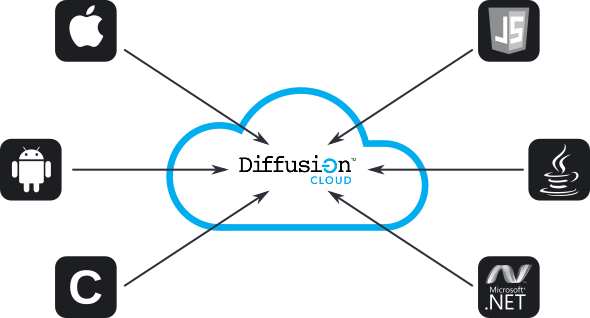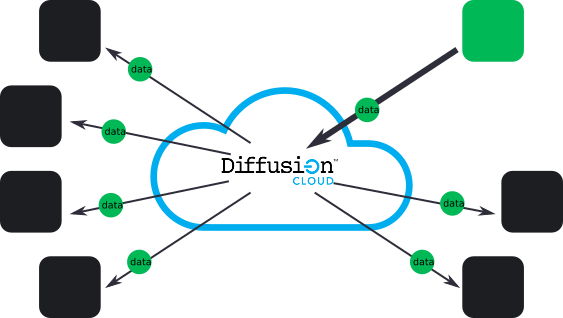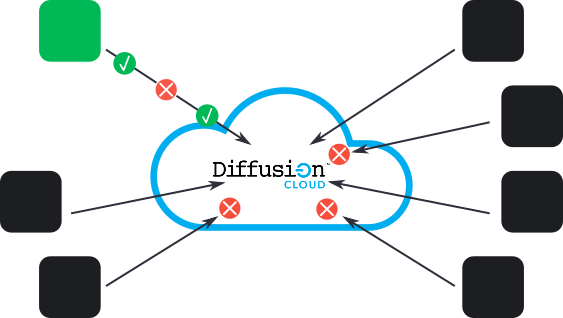Overview
Diffusion™ Cloud distributes your data scalably, reliably, and in real time. Diffusion Cloud gives you the toolkit to create high performance, value driven and robust web and mobile applications.
What is Diffusion Cloud?
Diffusion Cloud is an intelligent data streaming service.
It is the vital ingredient in your data distribution solution. Built on proven Diffusion technology, Diffusion Cloud efficiently distributes fast-changing data to your users. Diffusion Cloud provides:
Pub-sub: Organize data into topics that client applications can subscribe to. When you publish data to that topic, Diffusion Cloud pushes the data out to only those clients interested in that particular topic.
Bi-directional messaging: Send messages directly between your client applications and topic paths on your Diffusion Cloud service.
Data caching: Diffusion Cloud caches the most recent updates to a topic as the topic state. Clients that subscribe to topics don't have to wait for the next published updated before receiving data from a topic.
Efficient, realtime messaging: Diffusion Cloud is optimized to stream a high rate of messages to many connected clients.
Optimized distribution: Diffusion Cloud understands your data and can automatically remove out-of-date or redundant data.
Optimized performance: Diffusion Cloud understands how clients and connections are performing and can gracefully manage clients that need to resume sessions after a loss of connectivity.
Why use Diffusion Cloud?
It's quick to get started: It takes only minutes to request an instance of the Diffusion Cloud service that's ready to use out of the box and less than 10 lines of code to create a client that connects to Diffusion Cloud and subscribes to a topic.
It's in the cloud: Create your solution without the need to invest in in-house servers.
It's reliable and robust: On unreliable networks, Diffusion Cloud clients that temporarily lose connection can reconnect and resume their sessions. Diffusion Cloud only sends the data that has been missed since the connection was lost. Regardless of internet connectivity, Diffusion Cloud gets data to your clients, enabling you to provide high quality of service to your customers.
It provides client libraries for many platforms: Create web applications with our JavaScript® library, enterprise applications in Java™ or .NET, mobile applications for iOS® or Android™, and many more.
It's secure: Use role-based security to determine which clients can access resources on your Diffusion Cloud service.
Who uses Diffusion Cloud?
Anybody who has data they want to stream reliably and in real time can use Diffusion Cloud. Here are some example uses from a variety of industries:
e-Gaming: The mobile gaming market is expanding rapidly. Betting apps must provide constantly changing odds as play continues. That's where Diffusion Cloud comes in: handling the massive spike in users that comes with a major sporting event and delivering data to all of them in real time. Also the set of topics on Diffusion Cloud is elastic and can grow in response to new games and new betting opportunities.
Financial services: On the stock markets, prices can change in milliseconds. Trading apps can rely on Diffusion Cloud to deliver up-to-date information rapidly and in real time.
Transportation and logistics: As we travel and ship globally, the ability to communicate and collaborate in real time becomes increasingly important. Knowing which vehicle your parcel is on means you know where it is, second by second. The robustness and reliability of Diffusion Cloud enables clients on the move to get and send the data they need regardless of lapses in internet connectivity.
Broadcast and media: One of the biggest trends in customer engagement is the second screen. Diffusion Cloud enables second screen applications to move large volumes of data bi-directionally and in real time.
I'm convinced. What do I do next?

Request a Diffusion Cloud service and access it immediately through your web browser.
Getting started with Diffusion Cloud

Use our APIs to develop clients that interact with Diffusion Cloud.
Start subscribing with JavaScript
Start subscribing with Android

A client with the required permissions can create topics and publish data to them. Other clients can subscribe to the topics. Diffusion Cloud pushes updates on the topics out to subscribing clients.

A client with the required permissions can administer aspects of the Diffusion Cloud solution. For example, a client can handle authentication requests from other clients and allow or deny the requests.

Use the Diffusion Cloud dashboard to manage your Diffusion Cloud service.
Administering Diffusion Cloud from the Diffusion Cloud Dashboard
The manual is regularly updated, but if you require further help, see the articles and forums in our Support Center:
If you find any errors in this user manual, you can let us know by email: [email protected].